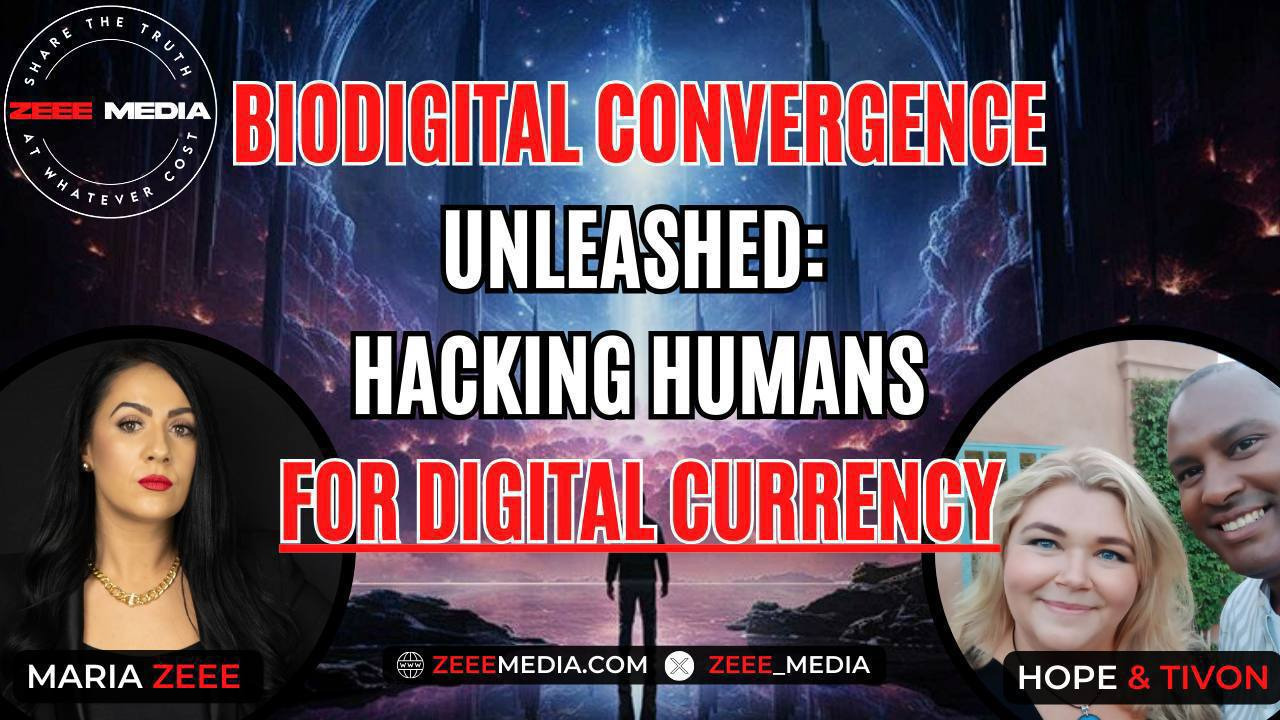Mark Of The Beast?: Social Media Is Getting Trump’s Digital Finance Revolution Completely Wrong.
By: Damian Fernandez
As influencers rage about “biodigital grids” and “mark-of-the-beast” currencies, they may be missing the real story: Trump’s GENIUS Act and the digitization of financial plumbing aren’t tools of tyranny — they’re a strategic strike against the Deep State’s monetary chokehold.
Editor’s Note
This article follows our previous analysis, The Deep State Showdown: Trump, Fink, and the Battle for the Digitized Dollar. In that piece, we examined how Trump’s GENIUS Act and Larry Fink’s quiet digitization of finance are reshaping the power lines of the global economy.
Today’s follow-up addresses a growing wave of social media panic — much of it misguided — about “biocyber control grids” and “digital enslavement” narratives spreading across alternative media circles.
1. Fear Sells, but Facts Matter
Over the past weeks, social media influencers like Maria Zeee, and Laura Aboli have been, directly or indirectly, sounding the alarm. They claim that stablecoins, the GENIUS Act, and BlackRock CEO Larry Fink’s recent comments about the “digitization of finance” are part of a grand plan to merge human biology with blockchain — an alleged “biodigital convergence” that will tie every person’s heartbeat or biosignal to a programmable digital wallet.
It sounds like a dystopian Netflix plot. But it’s not remotely what’s happening.
What these influencers have done — perhaps unintentionally — is conflate three entirely separate layers of technology:
legitimate financial digitization,
speculative biotech patents, and
the nightmare scenarios that haunt public imagination after decades of technocratic overreach.
Trump’s GENIUS Act is not a social engineering project. It’s a fiscal reset. It pulls stablecoins — digital tokens pegged to the U.S. dollar — back under Treasury jurisdiction. It requires that every U.S.-linked stablecoin be backed by real U.S. dollars or short-term Treasuries, anchoring the digital economy inside America’s monetary base.
That’s not enslavement. It’s economic repatriation.
“Digitization doesn’t mean domination. It means re-wiring the pipes that move money — not the people who use it.”
2. The Terminology Trap.
Term | What It Actually Means | What Influencers Claim It Means |
|---|---|---|
Stablecoin | A privately issued digital token backed 1:1 by U.S. dollars or Treasuries — essentially a digital bearer note. | A programmable currency that tracks your heartbeat or social credit score. |
GENIUS Act | U.S. law requiring transparency and asset backing for all U.S.-linked stablecoins — explicitly designed to block CBDCs. | Legislation enabling global biometric surveillance through crypto. |
CBDC | A digital form of national currency issued and controlled by a central bank. It allows governments to program, monitor, or even freeze transactions. While CBDCs could theoretically replace cash, in practice this would be unworkable — technologically, economically, and politically. Trump has explicitly ruled out any U.S. CBDC, emphasizing that digital money must remain under public and constitutional control. | The end of cash or private banking. That’s not so. Even in countries piloting CBDCs, cash and cards remain in circulation because everyday economies can’t run on centralized digital systems alone. Society will continue using physical dollars and private bank accounts. |
Tokenization | The digitization of assets (bonds, real estate, securities) for faster, transparent settlement. | Mistaken as “marking” human beings for economic control. |
The conflation of these terms isn’t harmless — it spreads fear, discourages informed discussion and plays straight into the hands of the same people and institutions these influencers oppose, sometimes referred to as the Deep State.
And here’s what gets lost in the noise: Neither Trump’s GENIUS Act nor Larry Fink’s “plumbing of finance” is about replacing everyday cash. You’ll still be able to walk into a diner, tip your waitress or buy a newspaper with physical dollars.
These initiatives operate at a different level or layer — the back end of the global financial system, where trillions move daily between banks, governments, and corporations. The digitization happening there is about efficiency and transparency, not personal surveillance. It’s like upgrading the wiring in a building — not installing cameras in every room.
When people confuse this “financial plumbing” with personal CBDC wallets, they invite panic and push the public away from understanding what’s actually happening — and more importantly, how Trump’s reforms could return America’s financial system to constitutional control — that is, back to the people, not the Deep State.
Under the old model, global liquidity was mediated through central banks, clearing houses, and institutions like BlackRock and the IMF — vast bureaucratic engines that could expand or constrict credit behind closed doors, with no direct oversight by citizens or even Congress.
What Trump’s GENIUS Act and Fink’s “digitized plumbing” quietly accomplish — whether by design or by convergence — is a decentralization of control over capital flows.
Fink’s modernization of the “pipes” (tokenizing bonds, digitizing settlements) creates transparency — every transaction is verifiable, immutable, and traceable on blockchain rails.
Trump’s framework ties stablecoin issuance to real U.S. assets (cash or Treasuries), ending the era of debt backed by nothing and making every dollar in circulation auditable.
Together, these shifts rebuild the dollar’s architecture so it operates openly, not in the shadows. This is not about centralized surveillance or programmable control of private wallets — it’s about restoring transparency and accountability to the very heart of money itself.
In this light, “bringing money back under constitutional control” means reclaiming the public’s ownership of the dollar — not through government intrusion, but through market-driven, transparent systems that even Congress can scrutinize. It’s the opposite of a CBDC: instead of a government-controlled coin, it’s a people-verified dollar.
3. What Is The Target Of The Digitization Drive?
a) Cross-border settlements.
This is the core target of the digitization drive. It includes:
Sovereign debt trades (e.g., foreign central banks buying U.S. Treasuries);
Private trade finance (corporate imports/exports, letters of credit, shipping, commodities);
Cross-border bond and securities transactions (think of eurodollar or offshore dollar markets); and
Interbank liquidity flows that today depend on SWIFT, correspondent banks, and multi-day clearing.
Tokenization replaces or bypasses much of that slow, opaque infrastructure. Instead of SWIFT messages that take days to settle, value transfers instantly on blockchain rails — settlement and messaging happen in one stroke. That’s why Fink calls it “new plumbing.”
b) Domestic settlements.
While cross-border is the focus, the same tech can modernize domestic money and securities movements:
Repo markets (short-term borrowing/lending between banks);
Inter-dealer settlements (e.g., stocks, bonds, derivatives cleared on national exchanges);
Central bank operations (open-market liquidity, Treasury auctions, etc.).
These systems don’t replace domestic fiat (cash or deposits) — they simply allow banks and institutions to move those assets faster, with fewer intermediaries.
c) Bypassing SWIFT — but not the banking system.
In essence, tokenized settlement systems sidestep SWIFT, because SWIFT is a messaging system not money movement. Blockchain rails merge those two layers.
However, they don’t eliminate banks — rather, they integrate banks as node operators or custodians in the new infrastructure.
d) Why it matters geopolitically.
This is why the U.S. is quietly embracing tokenized Treasuries and dollar-backed stablecoins. It keeps global liquidity on U.S. rails, not China’s CIPS or BRICS alternatives. It’s a way to modernize the dollar system without ceding control — or creating a retail CBDC that spooks the public.
4. What Fink Actually Said — and What Trump Actually Meant.
Let’s look at the facts.
Larry Fink has indeed said that “the digitization of all financial assets and currencies is coming rapidly.”
What he meant — in context — was the modernization of financial infrastructure, where bonds, currencies, and securities move seamlessly and transparently across blockchain-based rails. That’s not about your paycheck or your biometrics. It’s about the architecture of settlement systems — the “pipes” that make markets work.
Trump, on the other hand, has been openly opposed to CBDCs. During his campaign, he vowed never to let the Federal Reserve issue a programmable central bank wallet.
The GENIUS Act reflects that position. It anchors America’s digital monetary evolution in private-sector stablecoins, backed by real assets — not by central-bank code.
If anything, the Act builds a constitutional firewall against the very kind of surveillance-based currency that the “biodigital control grid” theorists fear.
“Trump’s play isn’t to digitize people — it’s to digitize accountability.”
5. The Real War: Who Controls the Plumbing of Money.
The real fight isn’t between people and machines. It’s between those who control the pipes of global liquidity and those trying to return that control to elected governments and markets.
For decades, the Deep State — through central banks, transnational funds and regulatory choke points — has monopolized those pipes. Trump’s GENIUS Act reroutes them.
By tying the digital economy back to the U.S. Treasury, he effectively short-circuits private and supranational control over the creation and circulation of digital dollars.
Fink’s role, intentionally or not, is that of a technocratic bridge — modernizing the financial plumbing that Trump intends to reclaim. The two may be adversaries in spirit, but their actions are converging on a shared outcome: a digitally fortified, dollar-centric system that can’t easily be hijacked by unelected institutions.
So, no — this isn’t a march toward “enslavement by blockchain.” It’s a geopolitical audit of the century’s most abused power source: money itself.
6. Why This Matters Now
If influencers want to do their audiences a service, they should be helping the public separate data panic from monetary policy. There are valid concerns about biometric data, surveillance capitalism and corporate overreach — but those are not the same battles as the digitization of sovereign debt, stablecoins, or blockchain-based settlement layers.
Every minute wasted confusing those fronts is a minute the real Deep State quietly regroups.
“The real danger isn’t that Trump’s digitized dollar will enslave humanity — it’s that fear and noise will stop it from freeing the system.”
————————————————————————————————————–

